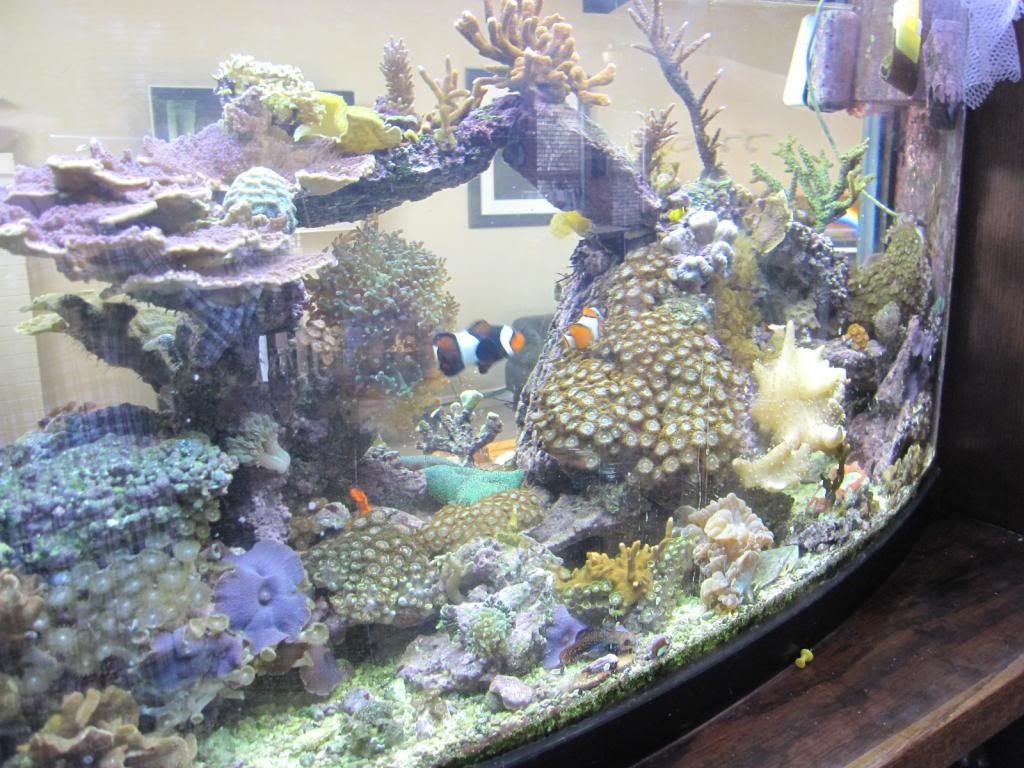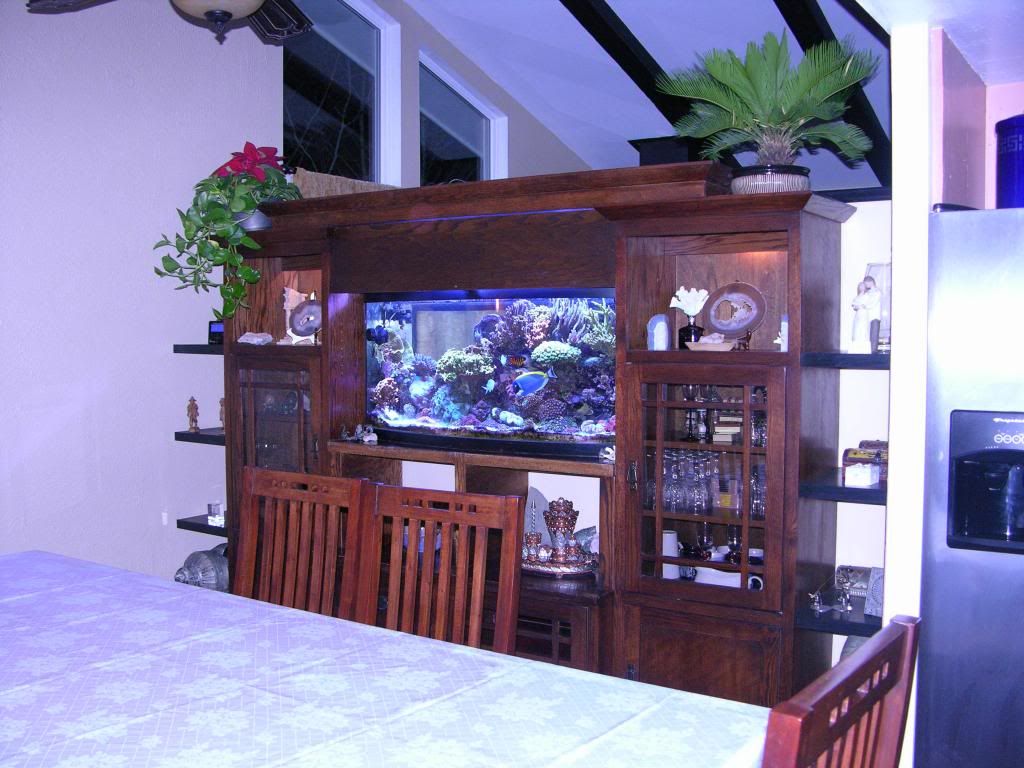[size=+2]NEPTUNE APEX SET UP & DESCRIPTION[/size]
[highlight]Be careful if you cut and paste, this coding works find for me, but each set up is different so be careful!! [/highlight]
[highlight]Post questions on code to another thread instead of this build thread please. [/highlight]
If you have questions about my setup, ask away, if it's about yours, pls make a separate thread or PM me.
Apex Name: ApexNome
Firmware: 4.20_CA12
Listing generated: 01/10/2013 08:12:59
PROGRAM:
// Program Variable Speed Ports (VSP) use profiles to control these ports, like programming for outlets go on or off, these VSP control intensity 0-100% for pumps and LED lights. For my reef, I have 2 VSP’s for pumps, and 2 VSP for LED.
[ Tunze_L ] ( base_Var1 ) // Goal is to have random variable flow, the different profiles are explained in that section, but the variety is to provide the randomness.
[ Tunze_R ] ( base_Var2 )
Program Type: Advanced
Display Icon: Left/Right Arrows
Program:
[ LED_White ] ( base_Var3 ) // These are the two Variable Speed Ports (VSP)to control intensity 0-100% for LED lights. For my reef, I have 2 VSP’s for pumps, and 2 VSP for LED.
Program Type: Advanced
Display Icon: Sun
Program:
[ LED_Blue ] ( base_Var4 )
Program Type: Advanced
Display Icon: Left/Right Arrows
Program:
[ SndAlm_I6 ] ( base_Alarm ) // I need to spend more time defining these and using them for items such as if PH rises or falls to a certain point or if I need a reminder
Program Type: Advanced
Display Icon: Sound B
Program:
Set OFF
[highlight]Be careful if you cut and paste, this coding works find for me, but each set up is different so be careful!! [/highlight]
[highlight]Post questions on code to another thread instead of this build thread please. [/highlight]
If you have questions about my setup, ask away, if it's about yours, pls make a separate thread or PM me.
Apex Name: ApexNome
Firmware: 4.20_CA12
Listing generated: 01/10/2013 08:12:59
PROGRAM:
// Program Variable Speed Ports (VSP) use profiles to control these ports, like programming for outlets go on or off, these VSP control intensity 0-100% for pumps and LED lights. For my reef, I have 2 VSP’s for pumps, and 2 VSP for LED.
[ Tunze_L ] ( base_Var1 ) // Goal is to have random variable flow, the different profiles are explained in that section, but the variety is to provide the randomness.
Program Type: Advanced
Display Icon: Up/Down Arrows //This should go away, be an option to remove
Program:Display Icon: Up/Down Arrows //This should go away, be an option to remove
Set Night_L // Set is the default. If no other profile is valid, the pump will be in Night_L
If Time 09:00 to 09:29 Then Dusk_L
If Time 09:30 to 21:59 Then Day_L
If Time 22:00 to 22:30 Then Dusk_L
If Outlet v_FlushTimer = ON Then FlushA
If Outlet v_Random = ON Then Random_L
If Outlet v_TunZtest = ON Then Day_L2
If Power EB4_6 Off 000 Then Night_L // If there is a power outage, the Tunze pumps are on a UPS, so they will work for more than an hour. I know the tank water will be lower, since the main return pump will be off. I do not want the water being pushed so strong it may make waves that will splash over the edge.
If Power EB8_4 Off 000 Then Night_L
If FeedA 005 Then Feed
If FeedB 005 Then Feed_2
If Outlet v_OVERFLOW!! = ON Then Night_L // There are float switches that prevent the tank from overflowing. My tank does not have a built in overflow, so there’s the inverted ‘U’ tube that takes the water from upstairs, down to the sump/fuge. If any part of that overflows or floods, the float switch triggers and the return pump shuts off. Same as a power outage, this lowers the intensity of the pump so there are no waves splashing over the edges.
[ Tunze_R ] ( base_Var2 )
Program Type: Advanced
Display Icon: Left/Right Arrows
Program:
Set Night_R
If Time 09:00 to 09:29 Then Dusk_R
If Time 09:30 to 21:59 Then Day_R
If Time 22:00 to 22:30 Then Dusk_R
If Outlet v_FlushTimer = ON Then FlushB
If Outlet v_Random = ON Then Random_R
If Outlet v_TunZtest = ON Then Day_R2
If Power EB4_6 Off 000 Then Night_R
If Power EB8_4 Off 000 Then Night_R
If FeedA 005 Then Feed
If FeedB 005 Then Feed_2
If Outlet v_OVERFLOW!! = ON Then Night_R
If Time 09:00 to 09:29 Then Dusk_R
If Time 09:30 to 21:59 Then Day_R
If Time 22:00 to 22:30 Then Dusk_R
If Outlet v_FlushTimer = ON Then FlushB
If Outlet v_Random = ON Then Random_R
If Outlet v_TunZtest = ON Then Day_R2
If Power EB4_6 Off 000 Then Night_R
If Power EB8_4 Off 000 Then Night_R
If FeedA 005 Then Feed
If FeedB 005 Then Feed_2
If Outlet v_OVERFLOW!! = ON Then Night_R
[ LED_White ] ( base_Var3 ) // These are the two Variable Speed Ports (VSP)to control intensity 0-100% for LED lights. For my reef, I have 2 VSP’s for pumps, and 2 VSP for LED.
Program Type: Advanced
Display Icon: Sun
Program:
Set OFF
If Time 09:30 to 10:00 Then OFF // My White LED’s have a few burnt out (my error) so when I try to vary the intensity, a portion of the lights blink. This is why I have on/off instead of calling on profiles to define the conditions of intensity.
If Time 10:01 to 11:45 Then ON
If Time 11:46 to 12:16 Then OFF
If Time 19:50 to 20:59 Then OFF
If Time 21:00 to 21:59 Then OFF
If Time 09:30 to 10:00 Then OFF // My White LED’s have a few burnt out (my error) so when I try to vary the intensity, a portion of the lights blink. This is why I have on/off instead of calling on profiles to define the conditions of intensity.
If Time 10:01 to 11:45 Then ON
If Time 11:46 to 12:16 Then OFF
If Time 19:50 to 20:59 Then OFF
If Time 21:00 to 21:59 Then OFF
[ LED_Blue ] ( base_Var4 )
Program Type: Advanced
Display Icon: Left/Right Arrows
Program:
Set OFF
If Time 09:30 to 11:59 Then AM-BLU_1 // The Blue LED’s call on these profiles to define the conditions of intensity. They ramp up and down depending on the time and profile.
If Time 12:00 to 19:49 Then AM-BLU_2
If Time 19:50 to 21:59 Then PM-BLU_1
If Time 22:00 to 22:30 Then PM-BLU_2
If Time 09:30 to 11:59 Then AM-BLU_1 // The Blue LED’s call on these profiles to define the conditions of intensity. They ramp up and down depending on the time and profile.
If Time 12:00 to 19:49 Then AM-BLU_2
If Time 19:50 to 21:59 Then PM-BLU_1
If Time 22:00 to 22:30 Then PM-BLU_2
[ SndAlm_I6 ] ( base_Alarm ) // I need to spend more time defining these and using them for items such as if PH rises or falls to a certain point or if I need a reminder
Program Type: Advanced
Display Icon: Sound B
Program:
Set OFF

















